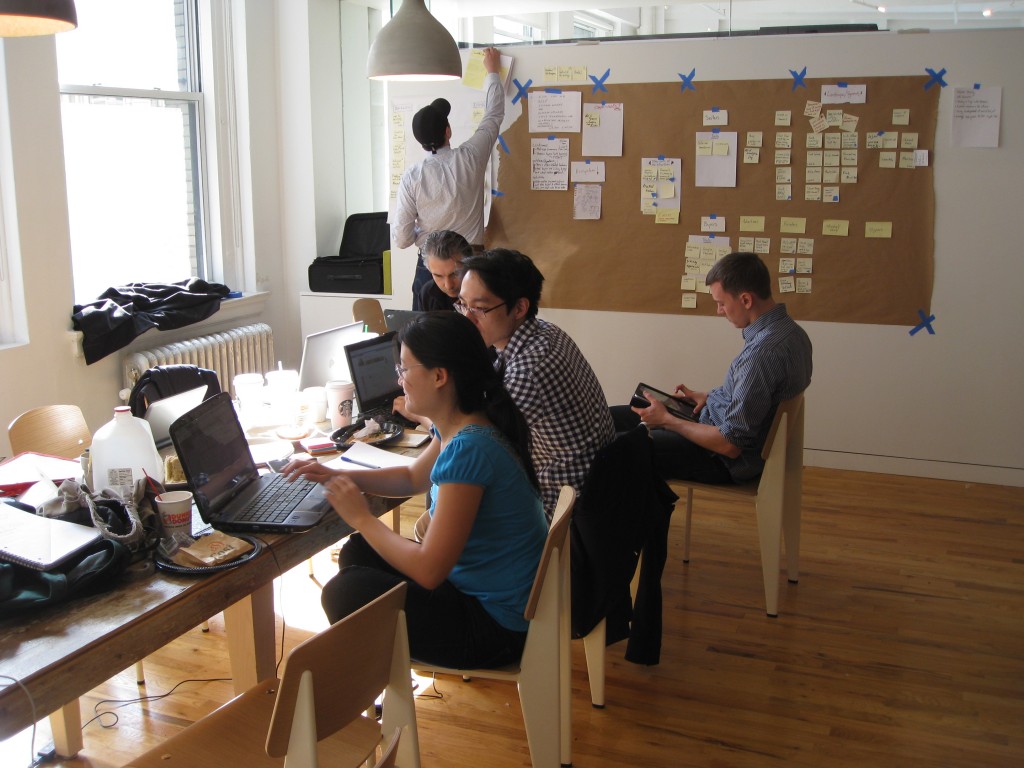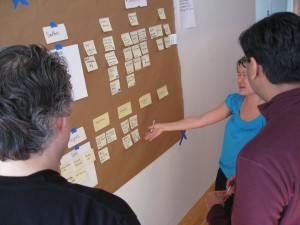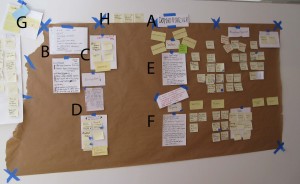I had a great time at Lean Startup Machine last weekend and learned a lot. I’d like to give a big shout-out to my collaborators, Gordon Agress, Joshua Haas, Miraya Yao, Ray Schmitz and Sebastian Park who were all enthusiastic, brilliant and cool under pressure. I sincerely appreciate the time and effort that the organizers and mentors contributed to making the event so great. It was amazing to spend the weekend with so many thought leaders in the Lean Startup space.
Rather than one long blog post about the whole event, I’ll start by writing about something our group found really helpful and several people asked me about, our sketchboard (that big brown piece of paper with all the stuff stuck on it).

The challenge
Lean Startup Machine weekend is intense and not for the faint of heart. In just 48 hours, you form a team, decide on an idea to pursue, and create a product using Lean Startup principles and activities. We needed to engage in customer discovery activities in an asynchronous, and yet coordinated way. How would we keep track of what we were doing and understand patterns as they emerged, without a lot of time for synthesis or reflection? Based on some good experiences I’ve had using sketchboards as part of the LUXr program, I decided to build a sketchboard to help us track our evolving understanding of the problem, the users and their needs.
What was on our sketchboard?
Our sketchboard evolved over the weekend. We added new information and put revised information on top of older versions, but the structure I established at the beginning held up pretty well. I tried to set it up so it supported telling a story about the problem we were solving. The project name and objectives at the top, problem, ecology and competitive information on the left, user research, segmentation and personas on the right.
Note: you can click on the image to see a larger version of the sketchboard
A – Our project name “DomainMatcher”
B – Our hypothesis, Customer-Problem-Solution statement
C – Competitors in the space
D – Sketch of the ecosystem, with subject matter experts (SMEs) outside buyers and sellers
E/F – This section started out as just two groups domain “sellers” (E) and domain “buyers” (F) but quickly evolved to visually represent our segmentation theory. Sellers were arranged by low # domains to high # domains held and buyers were arranged into buckets (founders, advertisers, blogger/vanity and flippers). The blue tape indicates we engaged with that person. The provisional personas (Sam the seller and Brenda the buyer) were added once we determined our early adopter targets and drew on elements we heard in our conversations with buyers and sellers.
G – Paper prototype of our buyer Minimum Viable Product v.1
H – A reminder of our goals for the weekend, “Question assumptions” “Iterate” and “Get out of the building.”
How it helped us
I expected that this would help our team keep track of the work to be done and help us create a shared understanding of emerging patterns. I was pleasantly surprised at how quickly people jumped in, contributed their own elements to the board and used it as a focal point for conversation. I believe a healthy sketchboard is owned by the entire team, and isn’t the work of a single person.

An unexpected side-benefit was how it made it easier for us to engage with other people. Several mentors and LSM participants came by, looked at the board and said “OK, I get it, here’s something I can do to help.” It was great to have a visual artifact we could use to quickly orient other people to our project and where we stood, pretty much in real time.
More about sketchboards
If you want to see another example of a sketchboard used in a slightly different way (with a nifty video), check out this post from the Adaptive Path blog “Sketchboards: Discover Better + Faster UX Solutions.”
More about Lean Startup Machine
Lean Startup Machine is a weekend long boot-camp where entrepreneurs learn Lean Startup principles through real-world problem solving and coaching from mentors that get it. In 48 hrs, you’ll pitch an idea, form a team and attempt to build something customers actually want. The prize? Cash, mentorship and glory. This is a single weekend that will change how you think about building startups forever.

This _worked_. The framework for capturing hypotheses, data, assumptions, research input, etc. made it much easier to stay oriented to what we were doing and where some task fit in. Orientation to the puzzle’s shape is no small feat when the puzzle pieces are changing. It also seemed to help quickly gather up inputs to the final presentation.
One extension might have captured networked resources, like the Buyer survey or the MVP landing page. Something brief, stating name, purpose, status, URL, login and password. That would help see what those were and given folks the information needed to capture the latest data. (But I would then designate an owner to coordinate over any changes to anything public facing, just to ensure that anyone with a view had a chance to be heard before some iteration.)
Maybe I should put something like this up on my office wall. Great idea, and well executed, thanks.
Having our sketch board out in the open where lots of people could walk up and take a look multiplied the effectiveness! This was visual candy that made it easy for other people to contribute.
Simply awesome. Sometimes low-tech is the best tech.
A few weeks ago we tried to reach out to the owner of a piece of real estate we were interesting in looking into.
No one could get ahold of her. Went through our contacts, a real estate broker, online directories, Google, etc.
Finally we told our adviser Michele about the problem and she responded “Oh, just call 411.”
Got it in 5 minutes.
Great post, thanks for sharing. Nice idea to include a sketch of the ecosystem. Here are my product discovery ideas: http://www.romanpichler.com/blog/agile-product-innovation/the-product-vision-board/